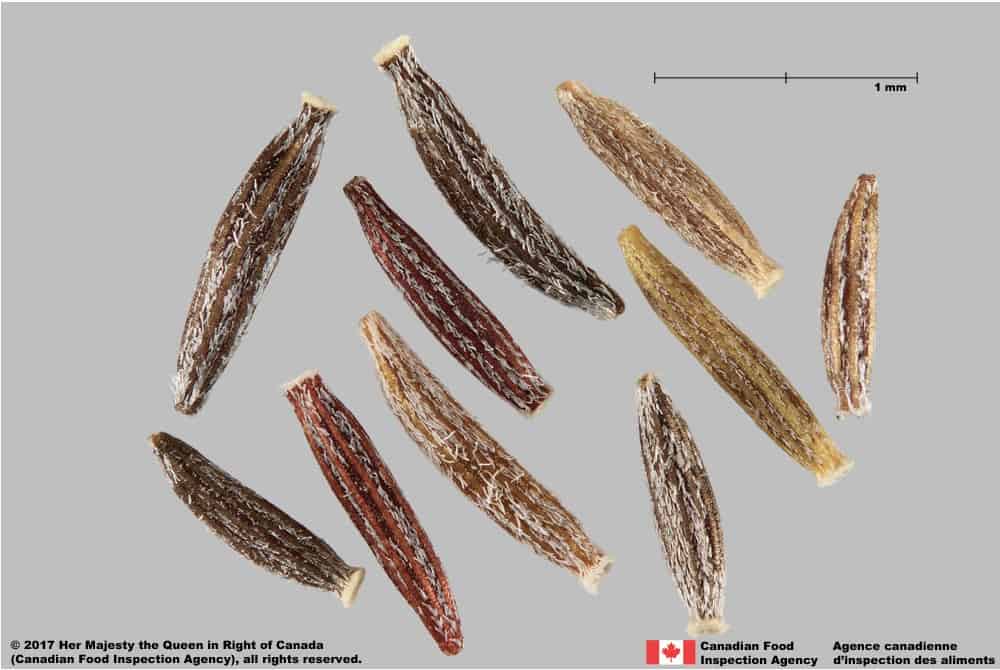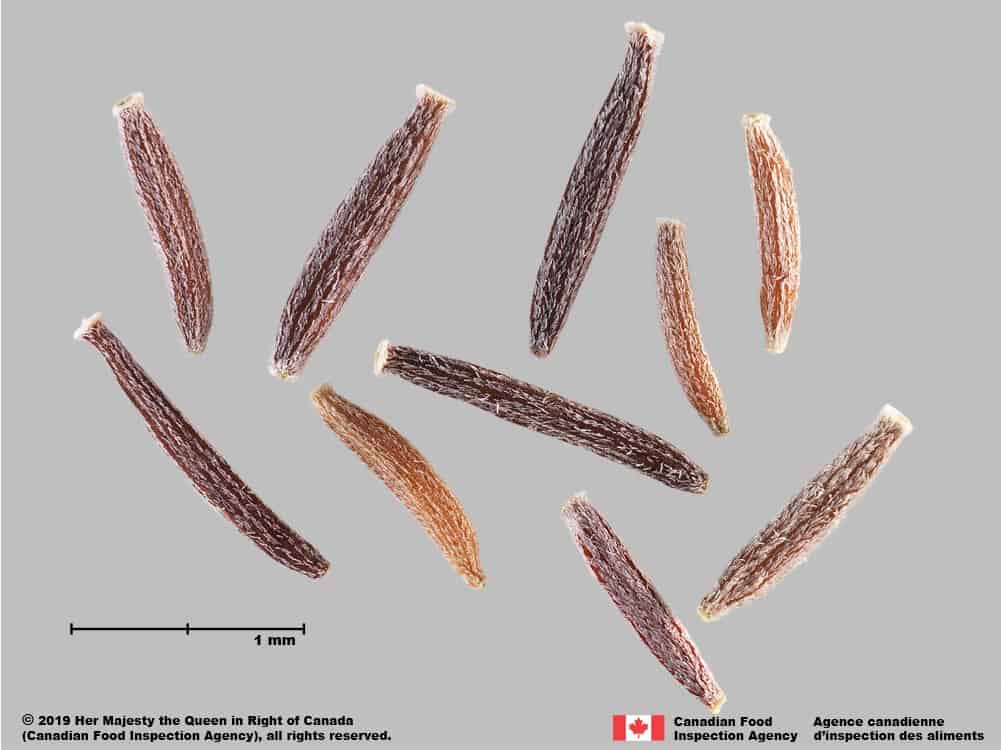Senecio madagascariensis
Overview
Aperçu
Regulation :
Remarques Réglementation:
- CFIA Weed Seeds Order - Class 1: Prohibited Noxious Weed Seeds
- List of Pests Regulated by Canada
- USA Federal Noxious Weed List
- USA Federal Noxious Weed Seed List
Regulation Notes:
Prohibited Noxious, Class 1 in the Canadian Weed Seeds Order (2016) under the Seeds Act. All imported and domestic seed must be free of Prohibited Noxious weed seeds.
Distribution :
Répartition :
Native to southern Africa and Madagascar and introduced to Argentina, Australia, Colombia, Japan, Kenya, Mauritius, Réunion and the United States (Hawaii) (CABI 2020). Absent from Canada (Brouillet et al. 2010+).
Habitat and Crop Association :
Habitat et Cultures Associées :
Colonizes a wide range of habitats, elevations and soil types. Often found in arid or moist pastures, coastal plains, yards, fields and roadsides (CABI 2020).
Economic Use, cultivation area, and Weed Association :
Utilisation économique, zone de culture et association de mauvaises herbes :
Duration of Life Cycle :
Durée du cycle vital:
Perennial
Dispersal Unit Type :
Type d’unité de dispersion :
Achene
General Information
RENSEIGNEMENTS GÉNÉRAUX
S. madagascariensis is a serious pest plant in Australia and Hawaii (Starr et al. 1999). This pioneer plant produces several thousands of seeds every year that are dispersed by wind or water (Starr et al. 1999). Infested pastures suffer lowered productivity through competition and toxicity to livestock (CABI 2020).
.Identification
Identification
-
Achene
Size
- Achene length* 1.7 – 2.1 mm; width: 0.4 – 0.5 mm
*Note: minimum and maximum of 10 achenes in a normal range of this species using image measurement (ISMA 2020)
Shape
- Achene is cylindrical with narrow, truncate ends, straight or slightly curved
Surface Texture
- Achene surface is stippled with several longitudinal ribs.
- Sparse, short white hairs between the ribs
Colour
- Achene is generally shiny reddish-brown, can be dark yellow or brown
Other Features
Pappus
- Immature achenes have a long, white pappus 2-3 times longer than the achene (CABI 2020)
- Pappus is easily detached from mature achenes (CABI 2020)
Achene end with pappus
- A small, thin style remnant is in the centre of pappus end
- The pappus end is wider than the opposite end
- A thick ring of white tissue is at the pappus end
Achene end without pappus
- The end opposite the pappus is narrower than the pappus end
- The ring of white tissue is thin on the end opposite the pappus
- A stalk is in the centre of this end, thinner than the style remnant at the pappus end

Madagascar ragwort (Senecio madagascariensis) achenes





-
Seed
Size
- Seed fills the achene
Shape
- Seed is cylindrical
Surface Texture
- Seed surface is smooth
Colour
- Seed grey coloured
Other Features
- Seed coat thin, whitish coloured adhering to the fruit wall
-
Embryo
Size
- Embryo fills the seed
Shape
- Embryo is spatulate, axial position
Endosperm
- Endosperm absent, nutritive tissue stored in the cotyledons
Other Features
- Cotyledons are soft-textured
Identification Tips
CONSEILS POUR L’IDENTIFICATION
The distinguishing features of the achenes of this species are short, worm-like hairs between the ribs, both ends narrow and with rings of white tissue.

Madagascar ragwort (Senecio madagascariensis) achene





Additional Botany Information
AUTRES RENSEIGNEMENTS BOTANIQUES
Flowers/Inflorescence
- Flowers yellow, daisy-like with both disc and ray florets (CABI 2020)
Similar Species
ESPÈCES SEMBLABLES
Similar species are based on a study of seed morphology of various species, and those with similar dispersal units are identified. The study is limited by physical specimen and literature availability at the time of examination, and possibly impacted by the subjectivity of the authors based on their knowledge and experience. Providing similar species information for seed identification is to make users aware of similarities that could possibly result in misidentification.
Senecio vulgaris L. (common groundsel)
S. vulgaris achenes are generally longer (length*: 1.9 – 2.7 mm; width 0.4 – 0.6 mm) than S. madagascariensis. The surface hairs are long and more dense with a ring of dense hairs around the end opposite the pappus, and only one end has a ring of white tissue compared to both ends of S. madagascariensis.
Senecio inaequidens DC. (South African ragwort)
S. inaequidens achenes are generally longer than those of S. madagascariensis (length*: 2.7 – 3.1 mm; width: 0.3 – 0.5 mm), has only one or no narrow ends and is generally darker coloured with more dense, longer hairs.
*Note: minimum and maximum of 10 achenes in a normal range of this species using image measurement (ISMA 2020).
Click to select species
Cliquez pour sélectionner les espèces

Senecio vulgaris

Senecio inaequidens
Comparison Window
Fenêtre de comparaison
MAIN SPECIES
ESPÈCES PRINCIPALES
Senecio madagascariensis

Senecio madagascariensis
Asteraceae
Madagascar ragwort (Senecio madagascariensis) achenes
MAIN SPECIES
ESPÈCES PRINCIPALES
Senecio madagascariensis

Senecio madagascariensis
Asteraceae
Madagascar ragwort (Senecio madagascariensis) achenes
MAIN SPECIES
ESPÈCES PRINCIPALES
Senecio madagascariensis

Senecio madagascariensis
Asteraceae
Madagascar ragwort (Senecio madagascariensis) achene
MAIN SPECIES
ESPÈCES PRINCIPALES
Senecio madagascariensis

Senecio madagascariensis
Asteraceae
Madagascar ragwort (Senecio madagascariensis) achene, close-up of surface
MAIN SPECIES
ESPÈCES PRINCIPALES
Senecio madagascariensis

Senecio madagascariensis
Asteraceae
Madagascar ragwort (Senecio madagascariensis) achene, top-down view
SIMILAR SPECIES
ESPÈCES SEMBLABLES
Senecio vulgaris

Senecio vulgaris
Asteraceae
Common groundsel (Senecio vulgaris) achenes
SIMILAR SPECIES
ESPÈCES SEMBLABLES
Senecio vulgaris

Senecio vulgaris
Asteraceae
Common groundsel (Senecio vulgaris) achenes
SIMILAR SPECIES
ESPÈCES SEMBLABLES
Senecio vulgaris

Senecio vulgaris
Asteraceae
Common groundsel (Senecio vulgaris) achene
Need ID Help?
Besoin d’aide pour l’identification?
Reference(s)
Référence(s)
Brouillet, L., Coursol, F., Meades, S. J., Favreau, M., Anions, M., Bélisle, P. and Desmet, P. 2010+. VASCAN, the database of vascular plants of Canada. http://data.canadensys.net/vascan/ Accessed November 24, 2020.
Centre for Agriculture and Bioscience International (CABI). 2020. Invasive Species Compendium, CAB International, Wallingford, UK. https://www.cabidigitallibrary.org/journal/cabicompendium Accessed November 24, 2020.
Global Biodiversity Information Facility (GBIF) Secretariat. 2022. https://doi.org/10.15468/39omei Accessed via https://www.gbif.org/species/3107722 Accessed December 29, 2022.
Government of Canada (GC). 2016. Canadian Weed Seeds Order. https://laws-lois.justice.gc.ca/eng/regulations/SOR-2016-93/page-2.html (English) https://laws-lois.justice.gc.ca/fra/reglements/DORS-2016-93/page-2.html (French)
International Seed Morphology Association (ISMA). 2020. Method for Seed Size Measurement. Version 1.0. ISMA Publication Guide.
Starr, F., Martz, K. and Loope, L. 1999. Fireweed (Senecio madagascariensis): An Alien Plant Report. USGS Biological Resources Division, American Water Works Association Research Foundation, Maui County Board of Water Supply.
U.S. Department of Agriculture-Natural Resources Conservation Service (USDA-NRCS). 2022. The PLANTS Database. National Plant Data Team, Greensboro, NC USA. http://plants.usda.gov Accessed December 29, 2022.




